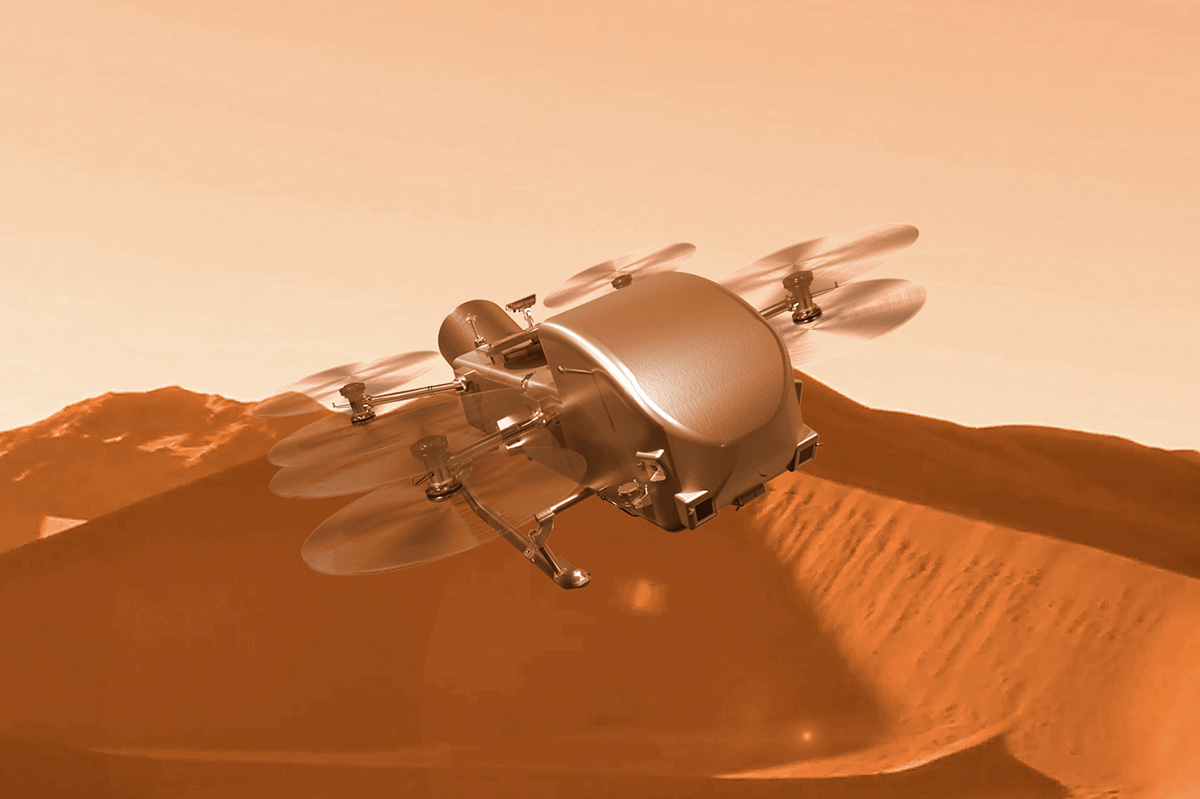Press Release
Dragonfly Mission Confirmed for 2028 Launch to Saturn’s Moon Titan
NASA has confirmed its revolutionary Dragonfly rotorcraft mission to Saturn’s organic-rich moon Titan. The decision, announced April 16, allows the mission to progress to completion of final design, followed by the construction and testing of the spacecraft and its science instruments.
“Dragonfly is a spectacular science mission with broad community interest, and we are excited to take the next steps on this mission,” said Nicky Fox, associate administrator, Science Mission Directorate at NASA Headquarters in Washington. “Exploring Titan will push the boundaries of what we can do with rotorcraft outside of Earth.”
Led by the Johns Hopkins Applied Physics Laboratory (APL) in Laurel, Maryland, the Dragonfly spacecraft will launch to Titan in 2028. Following a roughly six-year interplanetary journey, the car-sized lander loaded with science instrumentation will fly between dozens of landing sites on Titan’s surface to advance our understanding of the chemical origins of life. A mobile eight-rotored lander that will fly autonomously, this game-changing mission will achieve critical planetary science and astrobiology objectives as well as advance aeronautics and space technology.
“The Dragonfly mission is an incredible opportunity to explore an ocean world in a way that we have never done before,” said Dragonfly Principal Investigator Elizabeth “Zibi” Turtle of APL. “The team is dedicated and enthusiastic about accomplishing this unprecedented investigation of the complex carbon chemistry that exists on the surface of Titan and the innovative technology bringing this first-of-its-kind space mission to life.”
Since the team’s selection for formulation in 2019, NASA has directed the project to replan multiple times as a result of funding constraints in fiscal years 2020 through 2022. To compensate for the delayed arrival at Titan, NASA also directed use of a heavy-lift launch vehicle to shorten the mission’s cruise to Titan. In early 2023, the mission team successfully completed its Preliminary Design Review. At that time, the mission was asked to develop an updated budget and schedule to fit within constraints of the current funding environment. NASA confirmed Dragonfly with a total life-cycle cost of $3.35 billion and a launch readiness date of July 2028.
“APL is incredibly proud of the international team that has advanced the Dragonfly mission,” said Bobby Braun, head of the Space Exploration Sector at APL. “We are grateful for the confidence NASA has in this team and look forward to launching the agency’s first mission to the surface of a distant ocean world in 2028.”
APL manages the Dragonfly mission for NASA. The team includes key partners at NASA’s Goddard Space Flight Center in Greenbelt, Maryland; Lockheed Martin Space in Littleton, Colorado; Sikorsky in Connecticut; NASA’s Ames Research Center in Silicon Valley, California; NASA’s Langley Research Center in Hampton, Virginia; Penn State University in State College, Pennsylvania; Malin Space Science Systems in San Diego, California; Honeybee Robotics in Pasadena, California; NASA’s Jet Propulsion Laboratory in Southern California; CNES (Centre National d’Etudes Spatiales) in Paris; the German Aerospace Center (DLR) in Cologne, Germany; and JAXA (Japan Aerospace Exploration Agency) in Tokyo.
Dragonfly is the fourth mission in NASA’s New Frontiers Program, managed by NASA’s Marshall Space Flight Center in Huntsville, Alabama, for the agency’s Science Mission Directorate in Washington.

